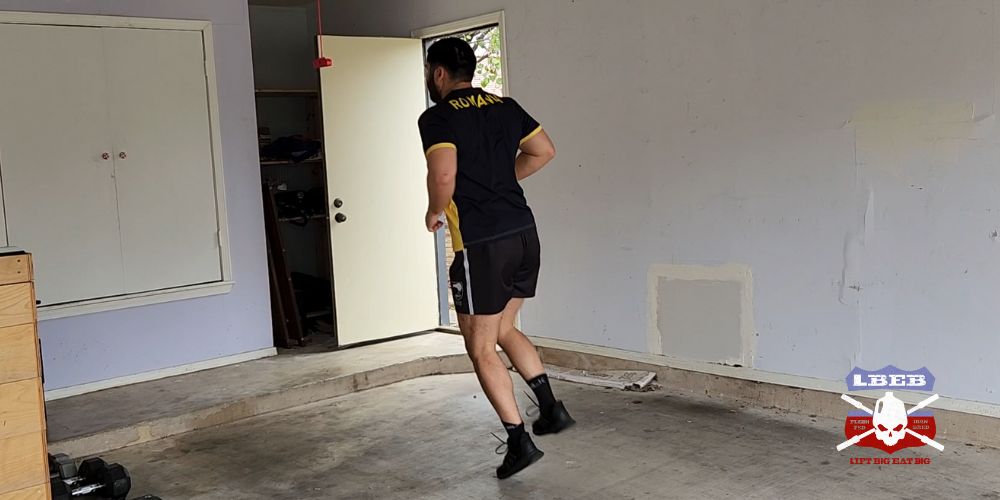Stop struggling and debating whether you should perform plyometrics before or after lifting. I have the answer for you.
Plyometrics done before lifting leads to larger performance improvements than plyometrics done after lifting.
But this is only part of the story. As you become more advanced, you may use plyometric exercises within a lifting session, and I’ll show you how.
Table of Contents
Should You Do Plyometrics Before Or After Lifting?
Plyometrics should always be done before or during a lifting session. Let me touch on doing plyometrics before lifting first. The general rule I follow when programming for performance is fast to slow.
Meaning you start with your fastest movements and progress to your slow exercises. For example:
A1) Drop Jump
B1) Power Clean
C1) Back Squat
You want to perform your fastest movements when fresh to maximize speed and power. When you do plyos at the end of a training session, you’re already fatigued and can’t hit the required intensity.
A good example is a study on high-school soccer players [1]. Performing plyometrics before a soccer training session led to greater improvements in sprint, jump, and change of direction tests than performing plyometrics after soccer.
As you become more advanced, you can use plyos within a training session by supersetting them with heavy strength exercises.
This is called the complex method. It’s where you pair a heavy resistance exercise with a speed or plyometric exercise [2].
The idea is you “potentiate” the plyometric exercise by increasing force generation capabilities acutely, leading to potentially long-term performance improvements greater than plyometrics alone.
For example:
A1) Back Squat 3 x 3 @85-90% 1RM
Rest 1-8 mins
A2) Hurdle Hop 3 x 10
Rest 2-3 mins
Rest times vary significantly based on the heavy exercise and how strong you are. If you’re short on time, you can walk to the next exercise and minimize rest before the plyometric activity, but resting slightly longer is better.
Should You Do Plyometrics And Weights On The Same Day?

Doing plyometrics and weights on the same day depends on your training split. If you’re blocking your training days by training quality, you may perform plyometric exercise and weight training on separate days.
For example:
Day 1: Speed/Plyometric Training
Day 2: Strength/Heavy Weight Training
Day 3: Hypertrophy/Size Training
I’m not the biggest fan of this type of setup and rarely prescribe it. The reason is if you miss a day due to sickness, injury, or being busy, you miss the stimulus entirely for that week.
Instead, I prefer having either high and low days OR upper/lower split depending on where in the playing season you are and your training goals.
A high day will combine plyos and weight training, and a low day will be more hypertrophy/bodybuilding orientated.
This gives an undulating pattern to your training week, so you’re not burning yourself out. The upper/lower split is a great way to organize training when packing on size.
Your lower body days will involve plyometrics and be considered “high” days, while upper days are more strength and size-orientated and are “low” days.
Can You Do Plyometrics On Leg Day?
If you’re doing a bro split that splits training into muscle groups, you’re not training for performance but instead for muscle size. You can perform plyometrics on a leg day, but it doesn’t serve any purpose in this circumstance.
If it’s a lower body leg day in a different training split, then your plyometrics will be done on your leg day. This will give you the benefits of plyometrics.
Summary
Do your plyometrics before or during lifting to maximize speed and power development. Performing plyometrics after lifting dampens the effect since you’re already fatigued, leading to poor physical outputs.
References
1. Ramirez-Campillo, R., Alvarez, C., Gentil, P., Loturco, I., Sanchez-Sanchez, J., Izquierdo, M., … & Granacher, U. (2020). Sequencing effects of plyometric training applied before or after regular soccer training on measures of physical fitness in young players. The Journal of Strength & Conditioning Research, 34(7), 1959-1966.
2. Seitz, L. B., & Haff, G. G. (2016). Factors modulating post-activation potentiation of jump, sprint, throw, and upper-body ballistic performances: A systematic review with meta-analysis. Sports medicine, 46, 231-240.
